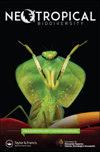Evaluación del estiércol de mamíferos nativos como potenciales atrayentes para el muestreo de escarabajos coprófagos (Coleoptera: Scarabaeinae)
IF 0.8
Q4 ECOLOGY
引用次数: 3
Abstract
ABSTRACT Mammalian dung represents a primary feeding and reproductive resource for most dung beetle species. Competition for the trophic resource is common among the subfamily Scarabaeinae showing different habits depending on the quantity and quality of food available. In this study, we evaluated the dung of six species of mammal native to Chiapas (Mexico) as attractants for sampling dung beetles. The six species have different feeding habits (carnivores, herbivores and omnivores) and the feces used were obtained from Zoo animals fed a standard diet. Sampling efficiency was over 99% for each of the attractants. Tapirus bairdii feces attracted the highest abundance, while Canis latrans attracted the highest richness and diversity was higher in Procyon lotor. The captured species showed no affinity for a specific attractant, and differences in richness, abundance, diversity, and species composition between baits were largely non-significant. These results suggest that when food availability is high, Scarabaeinae assemblages maintain very abundant populations with generalists feeding habits. However, other aspects such as the quality and quantity (volume) of the food may be important when choosing a resource. Hence, the use of different types of attractants that meet these characteristics offers the possibility of improving results in the monitoring of dung beetle communities in tropical forests, allowing the capture of those inconspicuous or rare species that inhabit the landscape.评价本地哺乳动物粪便作为食粪甲虫(鞘翅目:金龟子科)取样的潜在引诱剂
哺乳动物粪便是大多数屎壳郎的主要取食和繁殖资源。对营养资源的竞争在金龟子亚科中很常见,根据可获得食物的数量和质量表现出不同的习性。在这项研究中,我们评估了六种原产于墨西哥恰帕斯州的哺乳动物的粪便作为取样蜣螂的引诱剂。这六个物种有不同的摄食习惯(食肉动物、食草动物和杂食动物),所使用的粪便来自于喂食标准饮食的动物园动物。每种引诱剂的取样效率均在99%以上。白头貘粪便吸引的丰度最高,犬科动物粪便吸引的丰富度最高,多样性较高。捕获的鱼种对特定引诱剂没有亲和力,饵料的丰富度、丰度、多样性和种类组成差异不显著。这些结果表明,当食物供应充足时,金龟类的种群数量非常丰富,摄食习惯也很普遍。然而,在选择食物资源时,其他方面,如食物的质量和数量(体积)可能很重要。因此,使用符合这些特征的不同类型的引诱剂,有可能改善对热带森林中屎壳郎群落的监测结果,从而捕获栖息在这片土地上的那些不显眼或稀有物种。
本文章由计算机程序翻译,如有差异,请以英文原文为准。
求助全文
约1分钟内获得全文
求助全文
来源期刊

Neotropical Biodiversity
Environmental Science-Ecology
CiteScore
1.80
自引率
0.00%
发文量
39
审稿时长
24 weeks
 求助内容:
求助内容: 应助结果提醒方式:
应助结果提醒方式:


